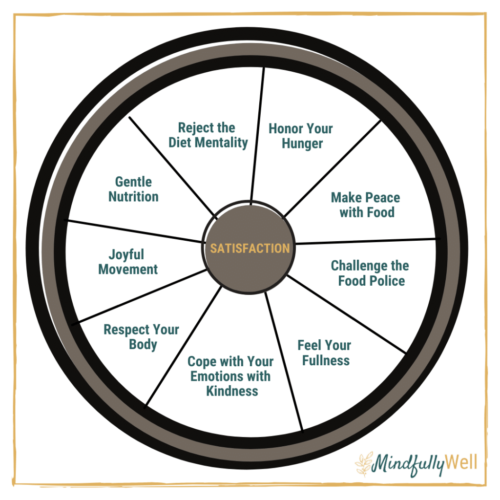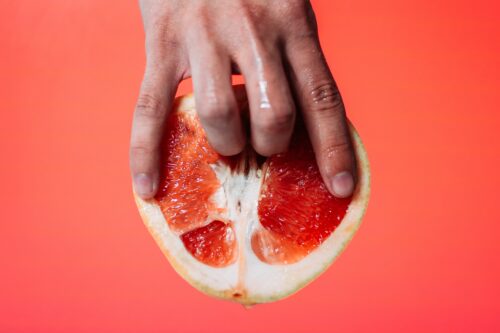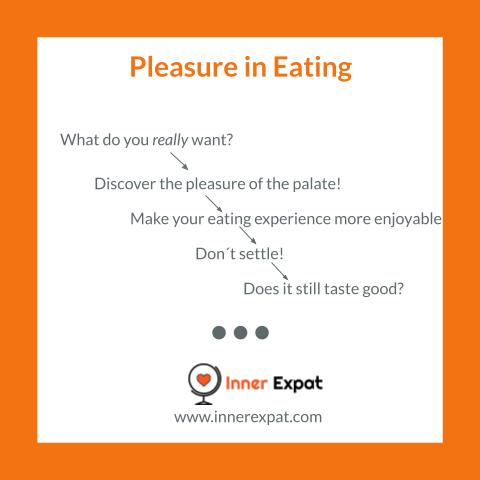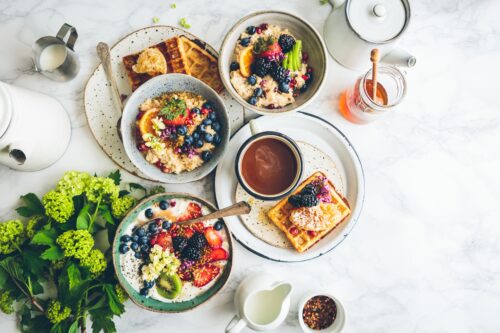Intuitive Eating – Discover the Satisfaction Factor or The Pleasure of Eating
I am halfway through the 10 Intuitive Eating Principles! Now learning about the fifth one, ´Discover the Satisfaction Factor´ or as I prefer to call it ´The Pleasure of Eating´. If you are new to my Intuitive Eating journey please check out the post which started it all off which also has links to all the principles I´ve covered thus far!
This sounds like the most straightforward principle of all I´ve covered on the face of it and I have whizzed through the chapter on it in my Intuitive Eating book but, (there is always a but!), I know it is not as simple as just enjoying my food. After years of dieting, restricting and thinking some foods were ´good´ or ´bad´ even starting to fully explore what foods I want at a specific time is going to be a challenge to tune into.
But I am ready for this new part of my journey and keen to explore!
The Pleasure Experience
The Japanese have the right idea approaching eating with a strong focus on pleasure rather than all the other fears around food that we can often place upon it.
According to Evelyn Tribole and Elyse Resch who started this new approach to eating finding satisfaction in food is integral to the IE process. We are invited to look at it as central to all, as in a hub in a wheel with 10 spokes being the Principles of Intuitive Eating.

Put more practically, to have a meal that is satisfying to us it has to really be what we want in that moment. For example, if we force ourselves to have a salad when we really want chicken and chips then we will not be truly satisfied. If we eat when we are extremely hungry then we are unlikely to fully appreciate the food as we may eat it so quickly, or if we eat something delicious but are overfull it can lead to us feeling uncomfortable. None of these experiences are very satisfying!
Instead we can allow ourselves to eat we can eat when we are moderately hungry – only what we truly want as we are not being monitored by the food police and have made peace with food. Then we can tune into our bodies and may decide we have had enough after several bites (or not!)
This does feel a bit like a leap of faith and I can certainly notice some fear in me if I truly eat what I want at any moment, could it mean I eat pizza and chocolate forever more?! That said there are plenty of questions to ask to really tune into what we want for a meal and to uncover some of our past thoughts and behaviours with food which we have also become more aware of from the start of our journey.
For example, how many times have you eaten a piece of fruit when you really wanted something else? Or a salad when you fancied a sandwich or something more filling? I know I have done that a lot and often makes me feel unsatisfied, reach for more food or eat lots of different foods and then ultimately ´succumb´ to what I wanted in the first place!
Foods as pleasure

Often us westerners have started to take the pleasure out of food as we try and use it to change or strengthen our bodies, instead of making it something pleasurable.
¨Make all activities pertaining to food and eating pleasurable ones´
is a Japanese guideline for eating healthily.
Our concept of eating healthily is certainly not based around pleasure!
This will require some exploration to find foods we truly enjoy, especially if we have lived with diet and restriction for so long.
One thing the book (thus far) has not mentioned about pleasure is also that we can find it elsewhere in life too. Meaning that I have often turned to food to cheer me up or when stressed, tired or looking for something nice to do, etc. There are other alternatives to finding pleasure or what we need in that moment whether it is a nap, a hot bath, reading a book, a chat with a friend, having sex, whatever – life is full of opportunities for pleasure, it is not all in an icecream tub!
We need not be afraid of enjoying our food and whilst may create some initial fears around uncontrolled eating, if we allow ourselves to fully enjoy food and listen to our bodies we are more likely to be fully present to what we truly enjoy until a point of satisfaction.
How to regain pleasure in eating?
There are five steps outlined:

Step 1 – Ask yourself what you really want to eat
We can only be satisfied with our food if we take the time to find out what we really want, having given ourselves unconditional permission to eat.
Often the problem is that we we have created so many rules or been on so many diets that we don´t really know what we want to eat let alone in a particular moment! By eating what we really fancy we may find that we actually get satisfied far earlier than we did then when we have eaten the foods we have permitted ourselves to in the past. If we only eat when we are genuinely hungry rather than by the time it is we may also change our eating habits and what we choose.
Step 2 – Discover the pleasure of the palate
Not really sure what you even fancy eating? This Principle is all about using all our senses to eat and explore our tastes. This sounds a lot to consider at first I think, but if we allow ourselves to really explore this in the comfort of our own home, it could actually be quite fun!
- Taste – by experimenting with our taste buds we can try different foods in our mouth to see where we sense sweet, spicy, salty, etc foods most and if this is different at different times of day. As a result we may find that we generally prefer savoury for breakfast, but something sweet later in the day or vice versa.
- Texture – if we move the food round our mouth and mindfully chew it to, we can see how different types of foods feel – whether it is smooth, crunchy, chewy or whatever. Again our preferences may be different from one day or time of day to the next.
- Aroma – sometimes this can be the most potent about whether we desire a food or not (I am now thinking of cooked bacon as I type this!). If we don´t like the smell of something it is likely to give us satisfaction let alone pleasure!
- Appearance – we have all heard the saying that ´we eat with our eyes´ – if something looks good then we are more likely to want to eat it. If I make a bit more effort with presentation or adding some fresh herbs, for example it can make all the difference to my experience.
- Temperature – might seem obvious but we are more likely to want a hot casserole or soup on a cold day and a cold drink, salad or ice-cream on a hot one. Have you ever asked yourself whether you really like lots of ice in your cold drinks or not? Sometimes we take what we have been given from childhood or whilst at a restaurant without really thinking about our preferences.
- Volume or filling capacity – the density of a food can make us feel more or less satisfied after eating. For example, a bowl of pasta or rice with something could hit the spot when you are hungry for lunch having done lots of activity sometimes, whereas other times some fish and roasted vegetables would do the trick.

When considering preparing a meal or snack the more we can try and ask ourselves questions around the above the more we will fill satisfied from our food. This will help inform our choices around what we plan for and buy when at the supermarket.
It is also suggested once we have made a choice and are eating our food that we eat a few bites and then check-in to see whether it is really what we wanted and whether we are feeling satisfied. This helps us confirm our preferences in that moment, start trusting ourselves and also check in with our bodies as to how full we are feeling.
Step 3 – Make your eating experience more enjoyable
We don´t always gives ourselves the best chance of doing this -for example, eating a sandwich at our desks at work or trying to have some toast or cereal as we get ourselves and our families ready for work/school. Instead we need to give ourselves more opportunities to enjoy our food whether that means getting up earlier (sorry for suggesting that one!), planning our meals in advance and allowing ourselves to take a break and really enjoy our mealtimes.
We need to remember to eat mindfully so we are fully present when we eat which can be helped by taking a few deep breaths before we start and paying attention to each mouthful and how we feel as we eat. Eating slowly, sensually and savouring every bite is the recommendation. This may not come easily at first, but I am confident it will with time.
It helps if, wherever possible, we eat when were are just mildly or pleasantly hungry rather than ravenous as we are less likely to eat mindfully in this situation!
Finally if we try and make mealtimes a time without stress or tension when we aren´t working, multi-tasking or using it as an opportunity to raise grievances with a partner or child. It is far less likely you will enjoy your meal and even that you wil not notice you have eaten it! I noticed this a lot with our with our kids when they were very young and we would try and eat at the same time as them, but trying to focus on them eating and myself often resulted in me feeling like I needed a second dinner as I hadn´t been present at all whilst eating my first one!
Step 4 – Don´t Settle
If you aren´t find it pleasurable or satisfying, don´t eat it. So many of us have grown up feeling we have to finish all that is on our plate, but just because we started something it doesn´t mean we have to finish it! This may not be the case if you are living in food scarcity, but we can always choose to save something for later or another day if needs be.
Having an altered mindset that we can eat what we want and when we want should allow us to be more relaxed about not having to eat whatever is in front of us just because it is there.
Step 5 – Does it still taste good?
I think we have all had times when we have started some biscuits, ice-cream, crisps, chocolate, whatever and then finished them without really realising it. Instead of doing this, we are invited to have a few mouthfuls and then check in to see if we are still enjoying it and want more. According to research it does not take many bits of food to reach ´taste satisfaction´ whether it is carrot sticks or some cake. The first few bites are the satisfying ones, the others are (usually) not the case.
We can experiment with this asking how much we enjoy something at the start of eating it and then a few minutes later and see whether we are hungry to and whether we might enjoy it later or not at all!

Experimentation
The key is to experiment with all of the above and allow ourselves to eat the full repertoire of food and play with it and see what works for us on any given day. If you eat a meal you don´t particularly like, be kind to yourself, you are learning and maybe you would enjoy that meal the next day or if you had been more hungry. The key to learning is allowing ourselves to make mistakes and learn from them, not to beat ourselves up about them as, guess what? That achieves nothing but makes us feel shame and guilt.
Yes, there will be times that we fall back into old habits, that we eat something that wasn´t our favourite or ate when we weren´t hungry. We don´t always have the food available to us when we want it or the time to cook the dish we would absolutely love. But we can start to learn more about our preferences which we can then evolve into by realising what we want to buy more of, or try, or seek out a different recipe idea. None of this is perfect, just like all learning, we learn in baby steps, one day at a time.
So here is to some time of experimenting with food. The kitchen is our laboratory for us to explore food; How and where we eat, how we present it and mindfully eat without distraction and allowing all foods to be permitted and seeing how we feel when we eat them, savouring each and every bite!
Let´s reclaim eating for pleasure and satisfaction!
How do you ensure you enjoy your food? What has worked for you to eat more mindfully and to tune into what you want to eat, when and how much? As usual, I would LOVE to hear your thoughts, questions and experiences so please do drop me a line below!
Images: Vika Strawberrika, Taras Chernus, Sieuwert Otterloo, Brooke Lark



